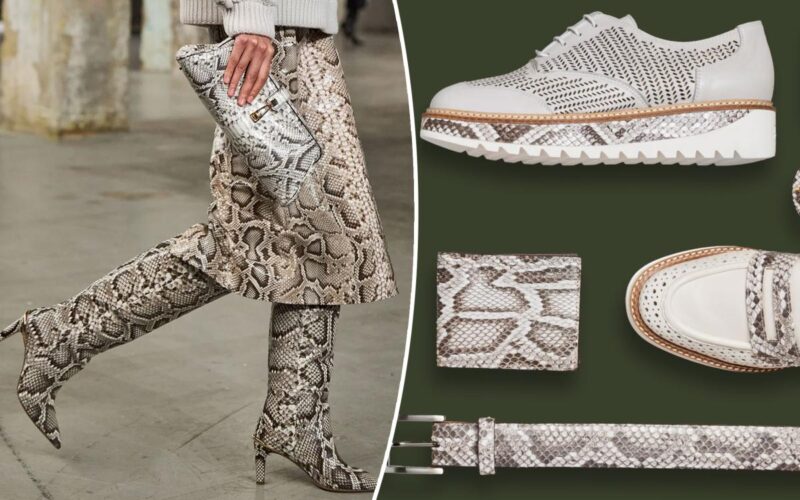Shopping will now save the planet.
Florida Governor Ron DeSantis announced this week that the state is taking an uncharacteristically classy approach to tackling one of its most notorious ecological threats — the invasive Burmese python — by literally turning the problem into luxury fashion.
The Sunshine State is renewing its efforts to remove the apex predators from the Everglades and transform them into A-list accessories, including boots, bags and belts, through a new partnership between the Florida Fish and Wildlife Conservation Commission (FWC) and Miami-based textiles manufacturer Inversa.
Florida python products have already been transformed into products for Rex Shoes and Chris Ploof, with items like the Damascus Cuff with Python Inlay going for $1,095.
“FWC’s partnership with Inversa has supercharged the removal of invasive Burmese Pythons from the Everglades,” Gov. DeSantis said in a statement. “The new program accomplished more removals in July 2025 alone than in the entire year before.”
With the help of a $2 million state investment, the collaboration builds on the success of the Python Action Team – Removing Invasive Constrictors (PATRIC) program, Florida’s front line in the fight against pythons since 2017.
Between May and July 2025, 1,022 pythons were removed — nearly triple the number caught during the same period in 2024. In July alone, 748 snakes were taken from the Everglades, more than the total for all of last year.
Inversa doesn’t just process the python hides — it also manages the front lines of removal. The company now contracts roughly 50 professional python hunters who previously worked under the Florida Fish and Wildlife Conservation Commission (FWC), effectively creating its own fleet of field specialists.
According to Inversa, each python hide helps protect up to 460 native animals that a single 13-foot python would otherwise consume in its lifetime, while improving the survival chances of 39 endangered species.
“These things will take out a deer,” DeSantis said, according to WESH. “It’s unbelievable what they’re able to do. A single python can threaten the survival of many endangered species.”
In an era when even the legacy luxury houses, including Chanel and Burberry, are banning exotic leathers amid animal welfare concerns, Inversa‘s model is part of a paradigm shift. Instead of relying on farming or illegal hunting, the company turns destructive invasive species into what CEO Aarav Chavda calls “ethical exotics.”
Inversa’s python garments have already hit the runway, with models in the Gabriela Hearst and KHAITE 2025 fall shows slithering down the catwalk in python jackets, handbags and more.
Hearst — who’s known for her sustainable and ethically produced designs — was one of the first brands to work with Inversa, calling the company a “game-changer” in an interview with Vogue last fall.
To date, Inversa has reportedly removed more than 50,000 invasive animals, including lionfish from Caribbean reefs and silverfin fish from the Mississippi River Basin, across ecosystems around the world, and processed them into luxury leather goods available in a range of colors — from natural matte finishes to bold hues like pink, yellow, and green.
Chavda told The Palm Beach Post that the company is also leveraging technology to improve efficiency, including AI-powered aerial detection tools that help locate pythons in hard-to-reach areas. “We have been able to convert invasives into fashions for consumers from Paris to New York,” Chavda said.
Burmese pythons were first introduced to Florida in the 1970s through the illegal pet trade. Released into the wild, they quickly established breeding populations in the Everglades, where they became apex predators with no natural enemies.
A single female can lay up to 100 eggs at a time, and the snakes have decimated populations of native mammals and birds — from rabbits and raccoons to deer and endangered species like the Key Largo woodrat.
Since 2000, more than 23,000 wild Burmese pythons have been removed from Florida, according to FWC. Yet the problem persists, as the snakes continue to expand their range and adapt to new environments.
The state’s partnership with Inversa has not only boosted removal numbers but has also reduced the FWC’s administrative workload by 89% and increased python hunters’ pay by about 60%, according to the governor’s office.
FWC Chairman Rodney Barreto said, “Our partnership with Inversa and the Python Action Team Removing Invasive Constrictors (PATRIC) program highlights the milestones we’ve achieved against the invasive Burmese Python, which will benefit generations to come.”
The python-to-products pipeline complements other ongoing efforts, including the Florida Python Challenge, an annual public competition that draws participants from across the US and Canada. During this year’s 10-day event, 934 participants helped remove 294 pythons from South Florida.
DeSantis also announced that more federal land in Big Cypress National Preserve is now open for python removal after approval from the US Department of the Interior, giving hunters more access to key areas.
The governor urged lawmakers to continue funding python removal annually, emphasizing that the state’s early results show the potential of public-private cooperation.
“It’s been a pleasant surprise to see the progress,” DeSantis said, adding, “I will tell you some of the stuff is very fashionable.”
So shop till the python population drops.








